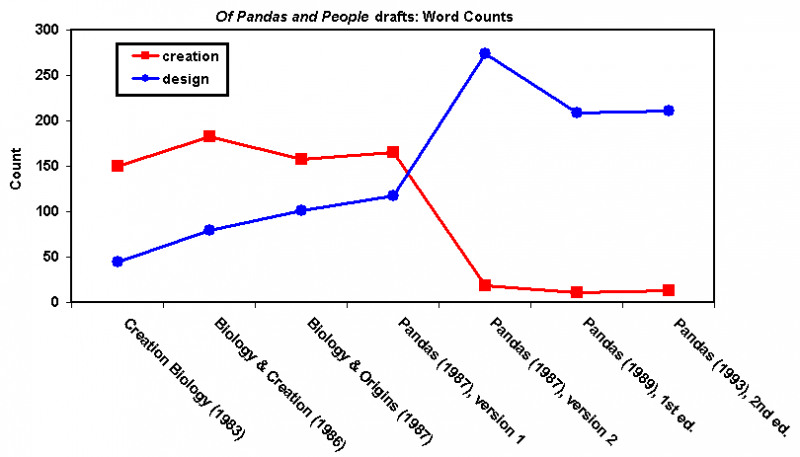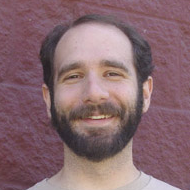The history of the “intelligent design” creationist textbook Of Pandas and People is probably known in greater detail than the history of just about any other textbook. Pandas was central to 2005’s Kitzmiller v. Dover trial, and was the first publication to lay out the major themes of the “intelligent design” movement. In the course of the Kitzmiller trial, material from NCSE’s archives led to a subpoena for the early drafts of Pandas, which demonstrated that the textbook started out as an overtly creationist project, and that references to “creationism,” “creationist,” “creator,” and related terms were swapped for “intelligent design,” “design advocates,” “designer,” and so forth. The infamous chart from Barbara Forrest’s testimony in Kitzmiller showed that switcheroo, and featured prominently in Judge Jones’s conclusion that intelligent design is a form of creationism.
In the course of the Kitzmiller trial, material from NCSE’s archives led to a subpoena for the early drafts of Pandas, which demonstrated that the textbook started out as an overtly creationist project, and that references to “creationism,” “creationist,” “creator,” and related terms were swapped for “intelligent design,” “design advocates,” “designer,” and so forth. The infamous chart from Barbara Forrest’s testimony in Kitzmiller showed that switcheroo, and featured prominently in Judge Jones’s conclusion that intelligent design is a form of creationism.
The publisher of Pandas, the Foundation for Thought and Ethics, is striking back now (PDF link), trying to rewrite that early history eight years after it was exposed and publicized.
John Buell, FTE’s president and the presumable author of the essay, argues that the research tying Pandas to its overtly creationist origins is all wrong. He claims that the references to “creationism,” “creation,” and “creationists” were all placeholders while they tried to invent new terminology, and that the vagaries of the publishing industry caused it to take three years to swap the terms out. He argues furthermore that talking about creationists is different from talking about creationism, since being a creationist could be construed simply to mean someone who believes in a god or gods. And he insists that the antonym for “natural” in passages rejecting natural evolutionary mechanisms is not “supernatural,” but “manmade” or “artificial.” Much of this is the standard dodge that ID creationists have always used when pressed on the identity of the designer, and much of the history Buell offers is already known. He does add some new details, and I’m looking forward to hearing Nick Matzke’s reaction. It would be interesting if he were to update or expand his fascinating chapter in But Is It Science? on the early days of the ID movement.
 What’s missing from Buell’s account is any reference to the actual genesis of the textbook. His history starts in 1983, two years after the project was first made public. That announcement came on the front page of the newsletter for the young-earth creationist group “Students for Origins Research,” now known as Access Research Network.
What’s missing from Buell’s account is any reference to the actual genesis of the textbook. His history starts in 1983, two years after the project was first made public. That announcement came on the front page of the newsletter for the young-earth creationist group “Students for Origins Research,” now known as Access Research Network.
In the Fall 1981 edition of the newsletter, which discussed the McLean trial in Arkansas and the early stages of the Edwards v. Aguillard lawsuit in Louisiana, there was a blurb promising an “unbiased biology textbook”:
A high school biology textbook is in the planning stges that will be sensitively written to ‘present both evolution and creation while limiting discussion to scientific data.’ Dr. Charles B. Thaxton is science advisor to the project and hopes to draw together an editorial board made up of both creationists and evolutionists.
The author selected is a teaching biologist with two McGraw-Hill books in print. A program of market research for this possible three year project is underway. For more information or input contact Dr. Thaxton at the Foundation for Thought and Ethics, P.O. Box 721, Richardson, TX 75080.
Buell is free to claim that the book was never about creationism, but in those early days, he and his colleagues made no bones about the fact that it was intended to “present…creation.” The project was hardly unique in aiming to “limit the discussion to scientific data.” In 1974’s Scientific Creationism (the “Public School Edition”), Henry Morris claimed “This book is needed by public school teachers for two main reasons: first, there is today a wide renewal of interest in creationism and, second, no other book is available which deals with all the important aspects of this subject in a strictly scientific context.” (Emphasis added.)
Buell insists that his book, unlike Morris’s and other overtly creationist efforts, wasn’t religious. As proof of FTE’s good intentions, he observes:
within the 30-day appeal period immediately following the 1982 district court ruling against the teaching of creationism in McLean v. Arkansas, Charles Thaxton and I met with Arkansas Attorney General Steve Clark in his offices in Little Rock, urging him not to appeal the verdict. Simply put, this was because FTE agreed that “creation science” promoted a religious viewpoint that was not appropriate for use in public schools, and that future court rulings would no doubt concur that it is not legal to advocate in public schools.
Given the timing of the announcement about the Pandas project (just as the McLean trial was going south for the creationists and as the stage was set for the Edwards trial), it’s just as reasonable to conclude that the inception of Pandas came as a response to the legal troubles in Arkansas, and that the decision to fully expunge those creationist origins did indeed come as a response to the Edwards ruling. FTE’s awareness, even early on, that overtly creationist arguments were unlikely to survive court review hardly invalidates the conclusion that the book was drafted as an attempt to circumvent constitutional limits on religious instruction in public schools. Buell’s protestations notwithstanding, the evidence he’s offering now doesn’t give any reason to change the conclusions of history and the courts about the creationist nature of the “intelligent design” movement.

